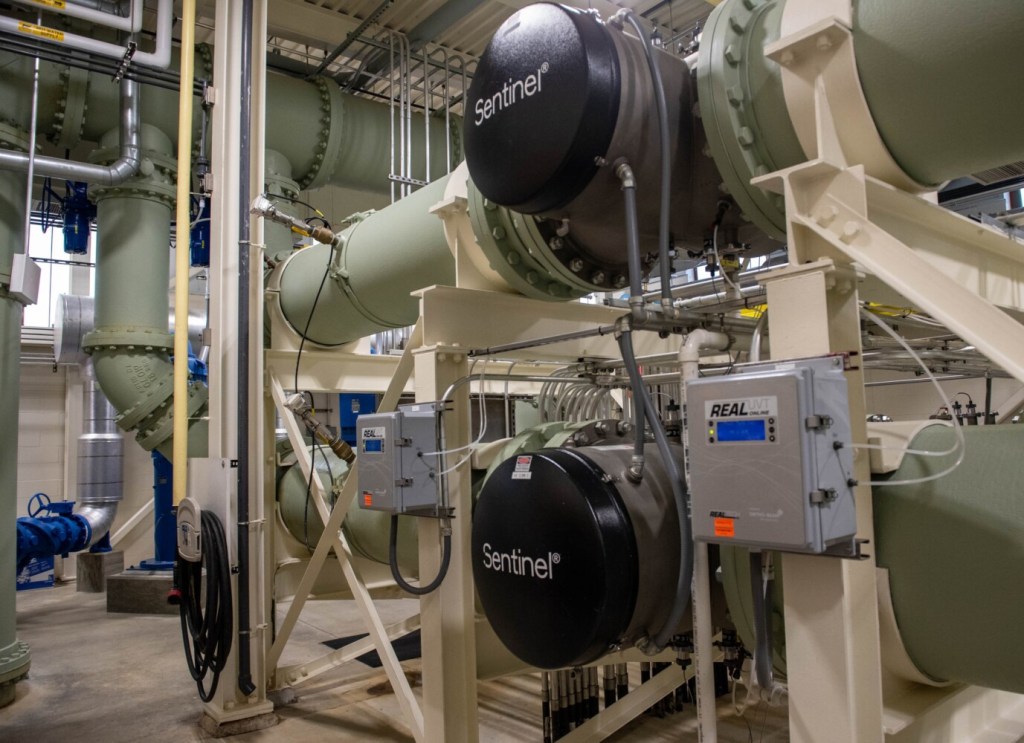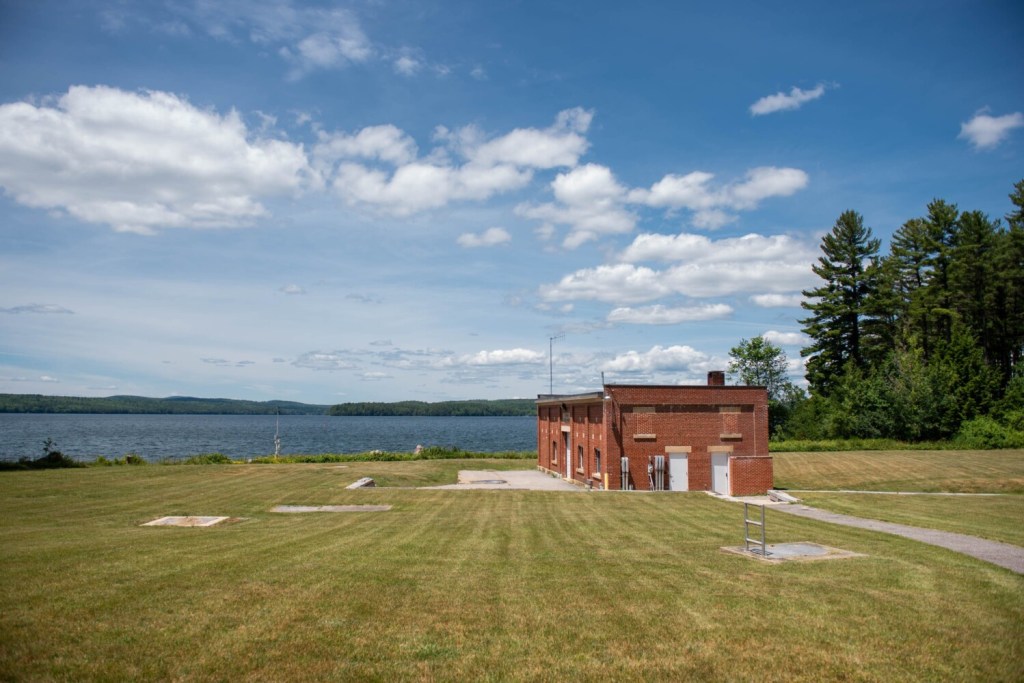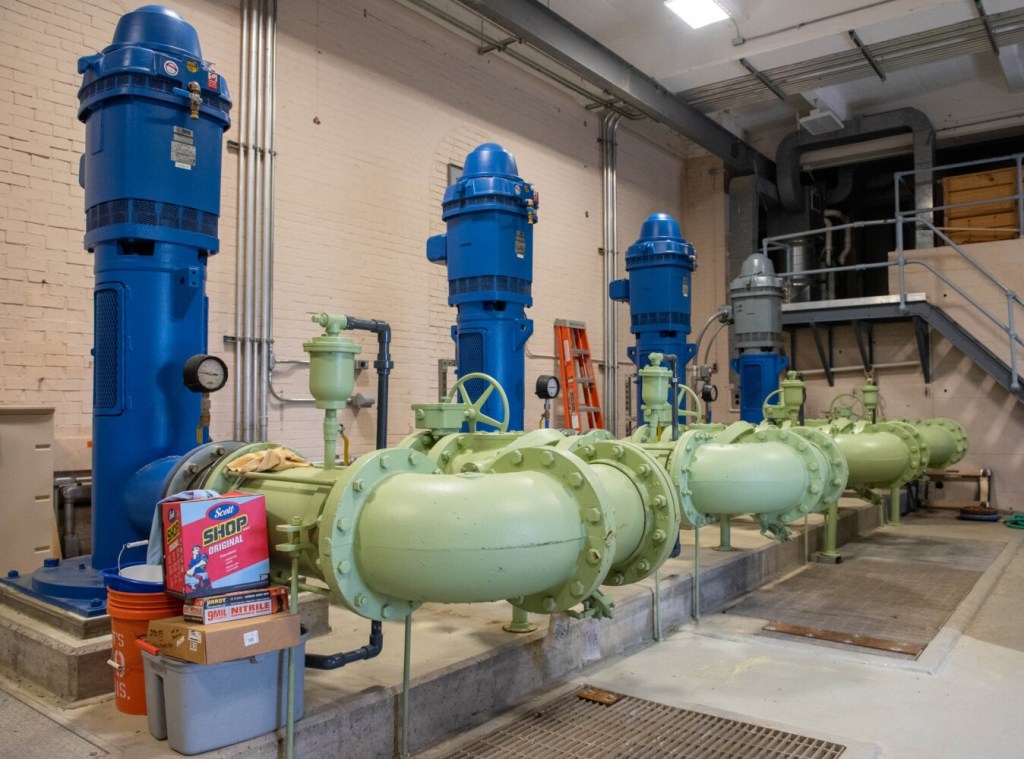AUBURN — In the summer of 2018, staff overseeing water quality at Lake Auburn watched as the turbidity level — one of the two main factors in determining overall quality — rose a worrying amount in a short period of time.
With water temperatures above average, and summer storms producing runoff, algae levels spiked and the water developed a green tint. The turbidity jumped from 0.6 to 3.1 NTU.
NTU, or nephelometric turbidity unit, is the unit used to measure the turbidity of a fluid or the presence of suspended particles in water. A measurement of 5.0 would be a violation of the district’s waiver from filtration, which allows it to deliver drinking water without a costly filtration system.
As a “preemptive measure,” the district applied an algaecide in September 2018. The water eventually cleared, but not before reports came in that fall of cucumber-tasting water. The culprit was algae. The next year, the district applied aluminum sulfate to the lake to remove algae-producing phosphorus, and it worked.
However, the need for such action over a two-year period prompted concern among water officials and researchers worried that climate change and more sources of runoff were leading to an increasingly volatile lake, prone to large swings in quality that could threaten the waiver.
For some, it’s also raised questions about the district’s ability to maintain its waiver for the long-term, putting a filtration plant back in the planning pipeline.
The waiver, which has been held by Auburn and Lewiston since 1991, has since been at the center of a passionate debate over the lake and proposed changes to watershed rules stemming from a 2021 report over how the watershed is managed.
The report’s recommendations, and the city’s subsequent pursuit of implementing some of them, has divided the community, including officials directly involved with lake oversight. At the same time that the Auburn Water District trustees argue they are committed to providing quality drinking water, signs saying “Protect Lake Auburn” can be seen throughout the city. Letters to the Sun Journal have poured in.
In the middle of it all is the specter of a lawsuit, filed against the Auburn Water District by the city of Lewiston, which argues that recent changes to the watershed boundary will result in the loss of the waiver.

The Lake Auburn water treatment facility is located on the shore of Lake Auburn and helps provide water for Lewiston and Auburn. Andree Kehn/Sun Journal
Once lost, it would necessitate the development of a filtration system paid for by taxpayers, with yearly operating costs paid for by water customers.
How close is the district from losing the waiver? Like everything else, it’s complicated.
REAL THREATS
According to Sid Hazelton, superintendent of the Auburn Water & Sewer districts, the lake has never been close to the 5.0 NTU benchmark for turbidity that would trigger a waiver violation.
But, another important parameter, coliform bacteria, has also given the district trouble in the past.
“The first real threat to our waiver came in 2004/2005 as our lake samples indicated elevated levels of coliform bacteria,” he said.

A fecal coliform test sample from the Townsend Brook Road tributary shows a small level of contamination. Levels of fecal coliform are expected in small tributaries connected to Lake Auburn. Any spikes in these levels would trigger an investigation. Andree Kehn/Sun Journal
The levels to maintain the waiver were exceeded, Hazelton said, which resulted in what’s known as an “Administrative Consent Order” being issued from the Maine CDC Drinking Water Program.
The district was required to put a gull management program into place, which continues to this day.
“This program has effectively reduced the threat,” Hazelton said.
Coliform bacteria, and E. coli, a type of coliform bacteria, have also been at the root of closures to the Auburn outlet, the city’s only public swimming hole.
In 2012, the district had its first real turbidity issue. It increased enough to create anoxic conditions that resulted in a fish kill, Hazelton said, prompting the district to apply for an algaecide permit in 2013 for future use if needed. It was eventually used in 2018.
While the district was granted a waiver due to historically clean water in Lake Auburn, it barely met the requirements.
Hazelton said the original filtration waiver approval from the state outlined that the qualification margin was narrow, and “the waiver was granted in part because of the watershed control activities that we planned to put into place.”
Jeffrey Jenks, then manager of the state’s Drinking Water Program, said at the time, “Although the Auburn Water District has met the minimum criteria for turbidity and total and fecal coliform bacteria levels, I must urgently caution you that the margin by which the district has qualified for the waiver is quite narrow and that the district risks exceeding these standards in the future.”

Ultraviolet light reactors sterilize water at the Lake Auburn water treatment plant in Auburn. Water runs through the reactor, which contain ultraviolet light bulbs in quartz sleeves. Andree Kehn/Sun Journal
Holly Ewing, an environmental studies professor at Bates College who has collected data on the lake for years, believes the lake is at a “tipping point.”
“A transition from the clearwater to the green state can happen rapidly, and the change is almost always permanent,” she wrote in a special to the Sun Journal in April. “The transition happens because nutrients such as phosphorus and nitrogen flow from the watershed into the lake, fueling algal growth. As algae decompose at the bottom of the lake, oxygen is depleted. This leads to chemical reactions that add even more nutrients, leading to a run-away cycle that lands the lake in a nutrient-rich, green state.”
She said that cycle is what happened to China Lake about 40 years ago, and “expensive filtration is required for the drinking water.”
The Lake Auburn water treatment plant, which provides the drinking water for Auburn and Lewiston, was built for $11 million in 2011, and was constructed to meet federal safe water regulations.
The water is treated with chlorine and ultraviolet light for disinfection, and is adjusted for alkalinity and pH. The plant also adds blended phosphate for lead control and fluoride.
Hazelton sees at least one of the recommendations from last year’s report, which proposes updates to septic design standards in the watershed, as “the latest threat to our waiver.”
Others, including water district trustees, don’t see it that way.
NEW ‘THREAT’
The report commissioned by the Auburn City Council, completed by FB Environmental, the Horsley Witten Group and the University of Maine, makes it fairly clear that additional development in the watershed will likely exacerbate water quality issues.
The report states that it found “no net environmental, economic or social benefit supporting expansion of development in the Lake Auburn watershed,” and said “more development cannot be allowed in the Auburn portion of the watershed even with low impact development requirements implemented in Auburn.”
Officials at Auburn Hall and on the AWD board of trustees argue that they are simply following the recommendations of a comprehensive report, which not only suggests ways to amend local ordinances but also to push towns in the upper watershed to do the same.

Water is pumped from the Raw Water Building up to the water treatment facility after being tested for particulate matter. Andree Kehn/Sun Journal
The city has already acted on two of them — implementing low impact development standards aimed at limiting the impact of runoff, erosion and pollutants from sites, and removing 148 acres near Gracelawn Road from the watershed boundary.
That move pushed the city of Lewiston to file its lawsuit, and a group of residents to launch a petition effort to repeal the decision.
In response to the increased public scrutiny, the Auburn Water District board of trustees recently hired a public relations team to conduct a website overhaul and social media campaign to help address what they said has been misinformation about their recent goals.
The next recommendation to be considered will be an update to the septic design standards in the watershed, which even the report acknowledges, may seem contradictory.
While most agree that the new standard, which would allow alternative soils to be used in designs, would be beneficial for the lake, the report said it could also potentially allow for the development of some 100 parcels of land that were previously unbuildable due to the current standard.
Steve Milks, president of the Auburn Water District trustees and city councilor, said the board has supported the recommendation to update the septic design due to what it could mean for the existing conditions.
City staff has said that more than 270 out of 350 septic systems currently in use in the watershed are outdated.
“Those are currently in the watershed, and have nothing to do with new development,” he said. “The board supports doing everything we can to make the lake cleaner. It’s an improvement to what the existing standard is.”
Milks has argued the issues present in the lake are there under the current conditions, which have taken hold under essentially no new development. To him, that means updated septic designs that can filter out more nutrients will only help.
“The science clearly shows that it would be better,” he said.
When asked about the development concerns, he said the city, through FB Environmental, is currently doing more research that will inform the Planning Board and City Council discussions this summer.

Turbidity analyzers in the water treatment facility for Lewiston and Auburn test water coming out of Lake Auburn. The higher the concentration of suspended solids in the water, the dirtier it looks and the higher the turbidity. Levels must remain below 5 NTU in order for the community to maintain its waiver which allows the lake water to be treated without being filtered. Andree Kehn/Sun Journal
Hazelton pointed to a recent letter to Auburn city staff from Drinking Water Program Director Amy Lachance, which stated that the waiver could be threatened if the conditions under which the waiver was granted are no longer in place.
“The conditions included the current watershed zoning ordinance,” he said.
Lachance’s letter also said, “We maintain that additional development has a greater potential to degrade water quality than an undeveloped land use, particularly a healthy forest, regardless of the protections put in place.”
A separate letter to Kevin Gagne, who oversees Lewiston’s Water Division, from the Maine Department of Environmental Protection regarding the proposed changes, said that while “considerable attention has been paid to the significant economic impact that would result from the loss of Lake Auburn’s filtration waiver, it’s worth pointing out that even if a new filtration operation is constructed, it is imperative that strict watershed controls remain in place.”
“Lake Auburn is a lake on the edge of not meeting state Class GPA water quality standards due to a decline in trophic state. This trend, which began in 2011, underscores the need for greater watershed protections than currently exist. Relaxing development standards risks irreversibly altering Lake Auburn’s water quality.”
Earlier this year, the Auburn water trustees directed Hazelton to pursue federal funds to help pay for the design of a filtration system, in the event that it’s needed, but the issue was ultimately tabled.
The district may soon look to its neighbors elsewhere in the watershed to also implement new standards. The FB Environmental report found that “Auburn alone cannot accomplish sufficient phosphorus load reductions to prevent deteriorating water quality in Lake Auburn, but will require active participation from the upper watershed towns.”
Send questions/comments to the editors.









